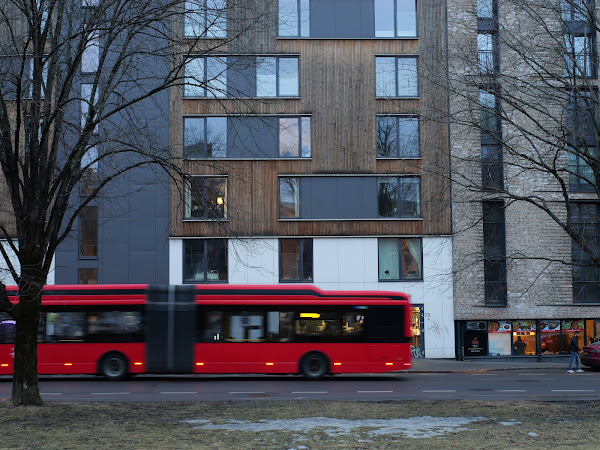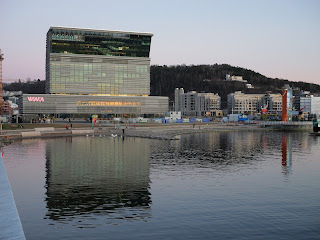Looking at the drive mode dial of the Lumix GH6, you'll see that it has changed quite a bit from the GH5. The "6K Photo" has disappeared, first of all. I think this was sad, since I used it quite a lot on the GH5. Contrary to what the name indicates, this is a video mode, not a photo mode. And it gives you 5.5K video recording, not bad for a consumer camera from 2017.
Another interesting feature in the "6K Photo" setting was the "Pre-Burst", able to capture one second of video recording from before you pressed the trigger, which gives a lot of interesting possibilities.
As this mode has disappeared, we get the "High Resolution" mode instead, which takes 8 consecutive pictures, using the in-body image stabilization to slightly move the sensor around to capture a staggering 100MP image, with 11552x8672 pixels. This mode can be used both on a tripod and handheld, and promises to take into consideration objects moving as you take the images, so that they still look sane. But what does this extra resolution look like, and does it give any real world advantage compared with a real high resolution camera? I'll check it out in this article.
For the test, I have used the Lumix GH6 with the Lumix 25mm f/1.4 lens and compared it with the Nikon Z7 fullframe camera, having a 45MP resolution, using a 50mm lens. With the 2x crop factor of the Micro Four Thirds format, both these setups have the same field of view. Both cameras were placed on tripod and used at base ISO for the test.
I took four different pictures:
1. Lumix GH6 in the normal mode (25MP).
2. Lumix GH6 in the high resolution mode (100MP) on tripod.
3. Lumix GH6 in the high resolution mode (100MP) handheld.
4. Nikon Z7 45MP.
To better compare the images, I scaled all of them up to 100MP. Here is what the scene looks like:
Here are 100% crops from the centre to compare (click for a larger version):
As you can see, there is a real and very impressive increase in the resolution with the Lumix GH6 high resolution mode. Even in the "handheld mode", without using a tripod, the resolution is clearly larger than that of the Nikon Z7 with a 45MP sensor. Sadly, I took the handheld image a bit later, so the lightning is different, but the resolution is clearly very good all the same.
There are some limitations: The ISO cannot be set higher than 1600 in this mode. The auto ISO function is automatically limited to 1600 when you select high resolution. Also, you cannot use longer exposures than 1 second. But these are fairly small limitations.
Here is another example image, taken in a quite low light situation: f/4, 1/40s, ISO 1250. In the scene there is movement: A big red bus passing which means that the images captured are different between the 8 frames (click for larger images):
Lumix GH6, normal mode (25MP)
|
|
|
Lumix GH6, handheld high resolution mode (100MP)
|
|
|
Nikon Z9 (45MP)
|
|
|
First of all, the movement seems to be handled very well by the Lumix GH6 High Resolution mode. The bus doesn't get chopped up, as you might expect, and the persons walking and running also seem normal.
Looking at the comparative resolution (click to enlarge):
Again, there is an impressive amount of details in the Lumix GH6 High Resolution mode.
How about using the feature for wildlife, then? I tried taking pictures of a crow using the Lumix 100-400mm lens at 400mm f/8. The bird was moving while I photographed, so I noticed that the camera failed to produce the high resolution image in some cases. But here is an example where it did work (click to enlarge):
| Normal (25MP) | Hand held high resolution (100MP) |
| |
And here are some comparisons (click to enlarge):
In this case, I think there is not really any extra resolution in the high resolution picture. Yes, it has more pixels, but the real resolution is quite similar. I'm guessing that as the bird moved during recording, the camera discarded many of the input files and was not able to make much use of them.
50MP or 100MP?
With the Lumix GH6 you can choose between the "LL" 50MP mode, or the "XL" 100MP modes. How do they compare? I have taken pictures at base ISO using both modes, for a comparison. Here is the scene:
It turns out that in both modes you get 100MP RAW files, but the JPEG files are 8192x6144 (50MP) and 11552x8672 (100MP) respectively.
To compare the details inherent in the JPEG files, here is a comparison:
Based on this, I would say that you get progressively more details by using the higher megapixel modes, however, the real advantage of 100MP over 50MP is perhaps not that significant. So using 50MP goes a long way in terms of capturing more detail.
Finally, here is an example landscape photo, which is probably the main use of the feature:
| Normal (25MP) | Hand held high resolution (100MP) |
| |
From these crops, we see that there is clearly better resolution in the handheld high resolution shot (100MP). It was taken at 23mm, f/7.1, ISO 1000. It is fair to assume that the resolution would have been even better at base ISO:
Conclusion
The Lumix GH6 high resolution mode is very easy and quick to use, and gives you a very real and signficant increase in resolution. It can be used for pretty much any landscape or cityscape photo. You can get both JPEG and RAW output in this mode.
Also worth noting is that when you use the high resolution mode, you don't only get the combined 100MP image, but also one normal image. So if it turns out that there is excessive movement in the scene while you record, and there are some strange effects because of this, you can still just delete the 100MP image and retain the normal one. Although I have not seen any evidence that movement would be a problem so far. So this mode is completely risk free to use.
When the high resultion mode first appeared on the Olympus OM-D EM5 II, I thought it was mostly a gimmick, and didn't use it much. But with the Lumix GH6, this mode seems usable in real life, and I am looking forward to using it more!





















